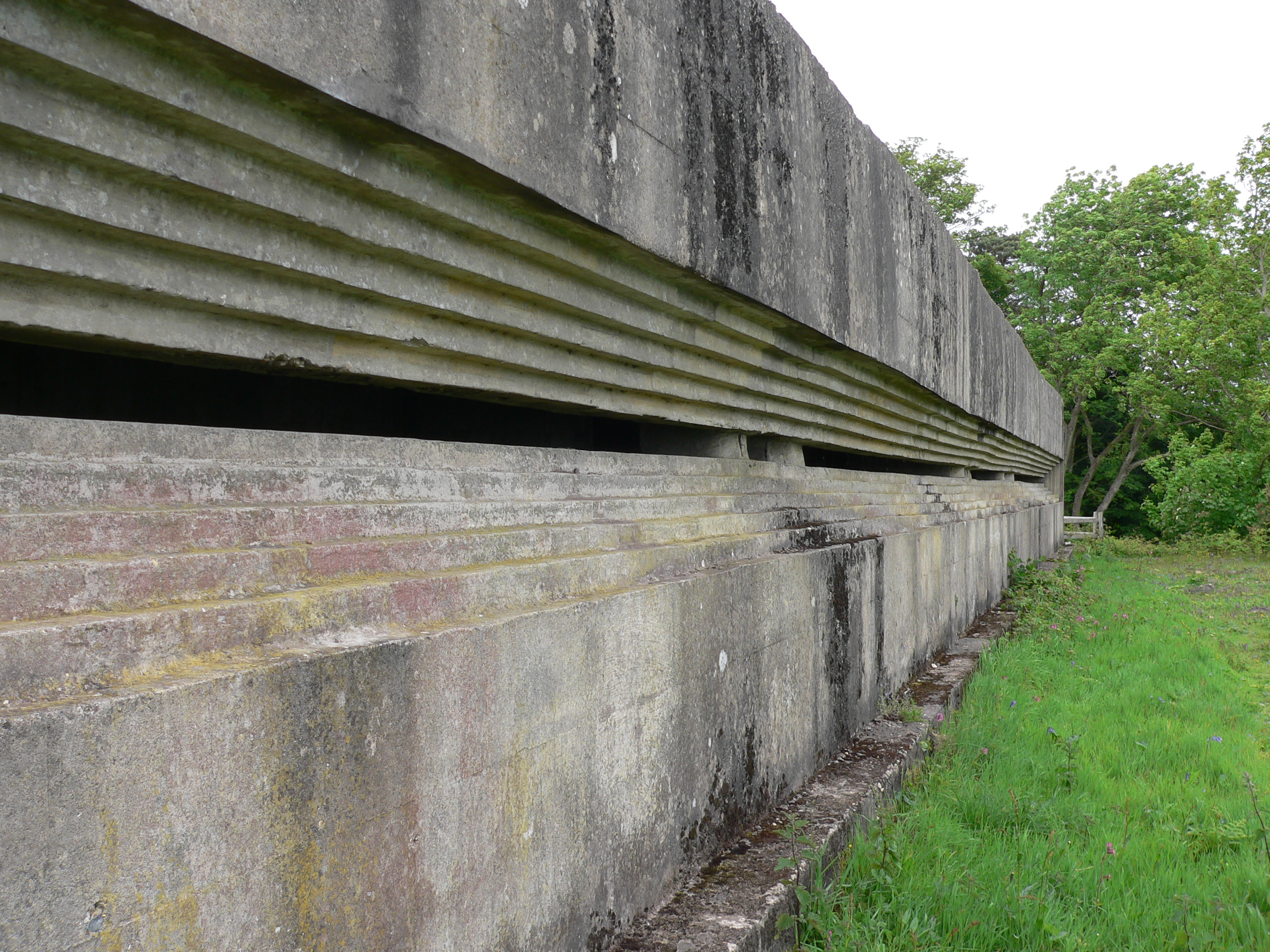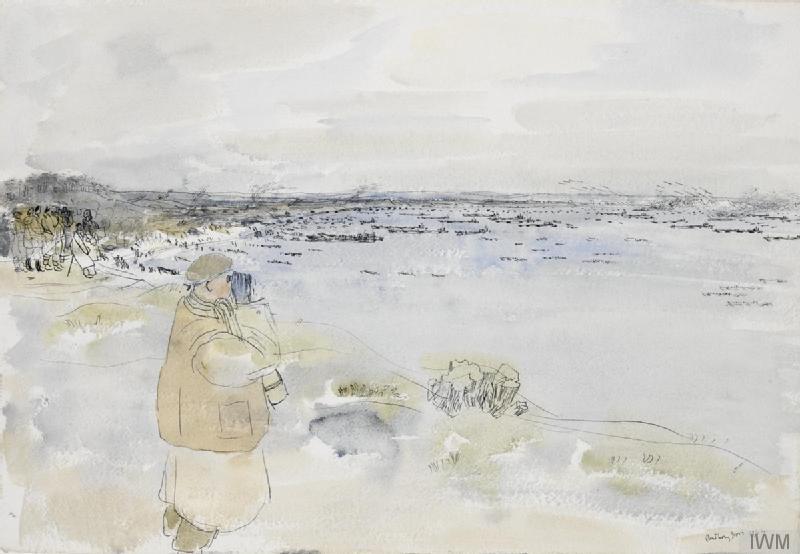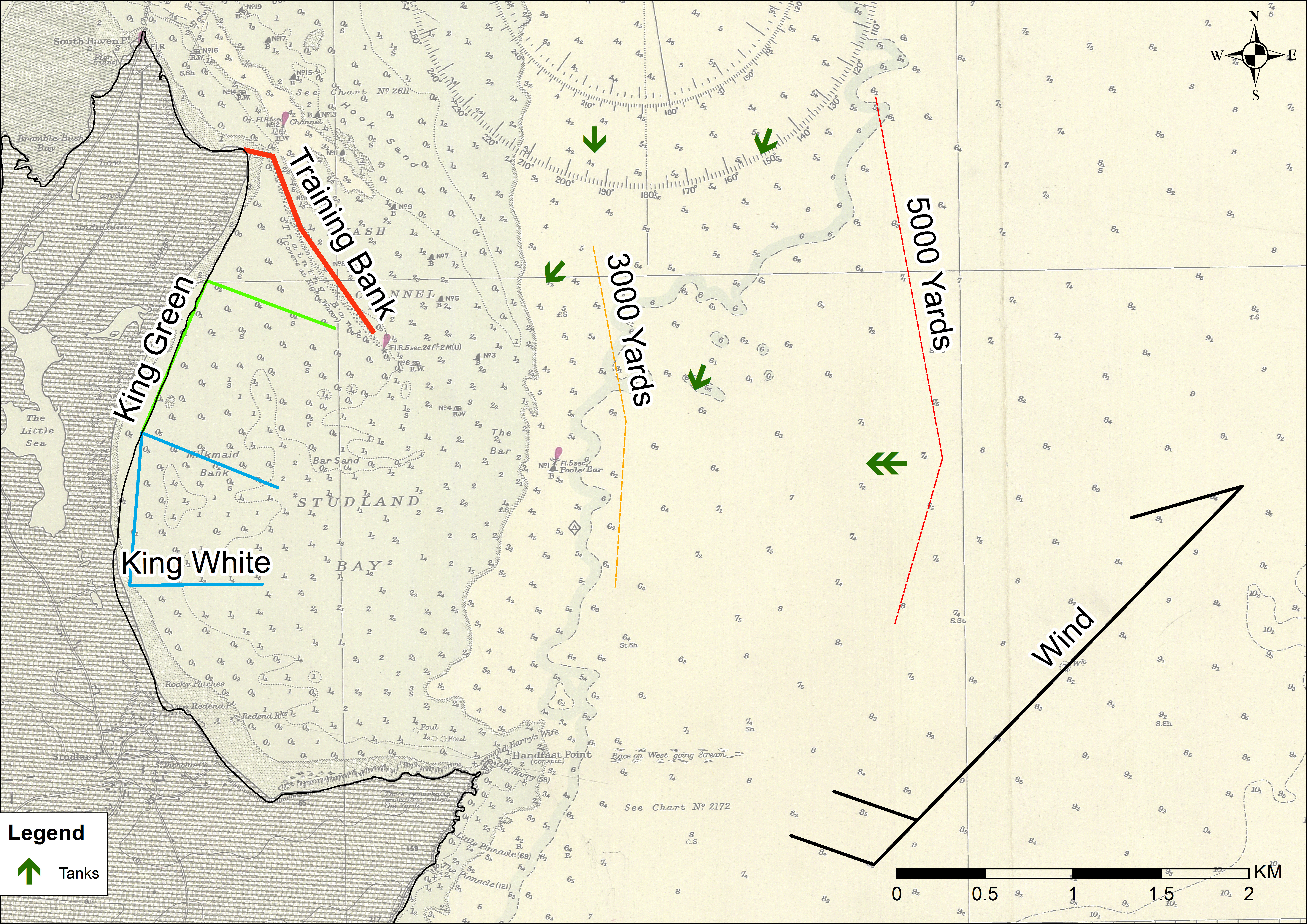Studland Bay
Studland Bay was occasionally used as a training area opposed to the B wing training school in the Solent. although not ideal in terms of landscape, similarity to the French coast or its exit points, it did have large sparsely populated beach and was one of the few available options in the region.
There the 4th/7th Dragoon Guards gave a full demonstration of LCT loading procedures on 11 and 12 December 1943 in front of Hobart upon completion of their training at B wing. This was the first time that a complete unit of DD tanks was launched from LCT’s at once. During this trial the tanks were launched from 1500 yards (c. 1400m) instead of the planned 3000 yards, but it reads that all tanks landed with two minor mechanical breakdowns. The memo goes on to say that ‘From a technical point of view this exercise proves conclusively that the DD tank is a very formidable new weapon’. The main lesson learnt here, was that the most dangerous period for the DD tank is its launch from the LCT.
Studland Bay also had several other functions in relation to the DD tanks. By 20 December 1943, three ‘hards’ (ramps used for the loading of LCT’s and other landing craft types) had been constructed for the 3rd Canadian Division to carry out exercises as well as Fort Henry an obsavational bunker built above the beach to watch the exercises.
Further trials to take place at Studland included driving a DD Sherman through a simulated flame barrage attack, known as Project FOUGASSE. This involved setting fire to oil on the sea, then the DD drove through the flames unharmed, using a device called a Belch, that would suck up sea water and then squirt it over the canvas skirt.
Studland Bay then became best known for exercise SMASH, one of the biggest live firing rehearsal of the Second World War.

Exercise SMASH I
Exercise SMASH was the code name given to a series of live fire beach assault training exercises taking place between 3 and 23 April 1944 in preparation for the Normandy landings on 6 June 1944. The first of these exercises was codenamed SMASH I.
Like D-Day itself ‘SMASH I’ was postponed by 24 hours due to the weather, taking place at dawn on 4 April. The aim of ‘SMASH I’ was to assault the beaches of Studland and establish a beachhead, observed by a number of ‘Class A’ (VIPS such as senior officers, commanders and government officials) in Fort Henry. In addition, ‘Class B’ officers watched the exercises from Ballard Down. The assault was planned to take place on two sections of the beach designated ‘King Green’ and ‘King White’, but due the presence of the training bank, a man-made breakwater which covers at high water, alongside the main shipping channel into Poole, the approach to ‘King Green would be restricted.
As part of this exercise two squadrons of DD tanks from the 4th/7th Royal Dragoon Guards, were launched from ten LCT 3s, each with 5 valentines, to support the infantry landings of the 50th Northumbrian Division and securing a series of objectives on land. The official war diary states the loss of the ‘special craft’ was due to ‘the wind getting up with a strong sea’, and the deaths of 6 men: ‘Lt. C.R. Gould, Sgt. Hartley, Cpl. Park 84, Tpr. Kirby and Tpr. Petty all of C Squadron, and Cpl. Townson of B Squadron’.
After the exercise was concluded the relevant officers held a conference after which all documents concerning Exercise SMASH were destroyed. One outcome of the losses was the appointment of a Regimental Officer as an advisor to Naval HQ on whether conditions were suitable to launch DD tanks.
On April the 18th The whole excercise was repeated as Smash III, this was the first time a whole regiment had been landed by DD tanks, this exercise was viewed by King George VI, Winston Churchill and General Eisenhower.

Circumstances of the loss
With the official records apparently destroyed details of the operation are based on eye witness statements and the archaeological record. The official accounts give weather as the primary reason for the loss of six tanks. The weather report for Portland and for Hurn shows the wind on 4 April 1944 to be a steady force 4 from the southwest all day, in the bay waves of up to 1m could be expected. Further, the exercise took place over the high-water slacks with the tide at c.1.6m above chart datum and at this state of the tide the training bank would be completely covered.
Lt (subsequently General Sir) Robert Ford later said of the incidents:
…We were on the surface of the water after coming off the landing craft and becoming increasingly apprehensive. The water was coming in very fast and although we had small pumps, they were just not effective. The weight of the water against the canvas was just too great. We knew we weren't going to make it. We were still floating and all four of us were standing on the top of the tank. Then a great wave crashed over the top and we sank to the bottom…
The suggestion the tank sank almost immediately after coming off the landing craft is correlated by another trooper of the 4th/7th Royal Dragoon Guards, R.W. Mole (1993), who describes waves ‘slopping in’ as the tank exited the landing craft leading to it being front heavy and going straight down, with some others drifting off before sinking.
Major J.D.P Stirling states the DDs were ‘launched in a very heavy swell, but one which was adjudged to be fit for launching’ (Stirling 1946: 43). He continues that shortly after launching the tanks the weather changed for the worse, ‘the wind increased, the waves grew bigger, and the tanks began to get into difficulties’. As the weather reports for the day show no sign of changing it is likely that the DDs turned into the wind giving the impression of increased swell.
These eyewitness accounts attribute the heavy sea state as a cause of the loss, but it is known from previous trials of DD tanks that they only had a freeboard of 12” (c.35cm) in a Force 1-3 winds with a calm sea state (ADM1/13246). This meant that even in moderate seas it could be expected that the tanks would take on water. Given the fact that the majority of the DD tanks launched at SMASH I reached the beach, albeit with some up to the drivers waists in water, other factors may have played a role in the loss of the six tanks.
While the DDs at SMASH I were launched from modified LCT 3s, prior to 1944 most launches were off LCT 4s and a letter (WO205/747: 9411) dated 24 December 1943 raises doubts that sufficient training and trials had taken place and whether under ‘operational conditions’ that DDs could be successfully launched from LCT 3s. In addition to this many of the DD training schools had not received the newly modified LCT 3s suggesting that the LCT 3 and DD crews had little experience in launching at sea especially if conditions were not ideal. This contrasts with the large amount of training in deploying from LCT 4s. From previous trials it was seen that the most dangerous part of the operation was the launching from the LCT, the ramp angles had to be precise to prevent the LCT from hitting the canvas skirt or the ramp hitting the prop, in rough or even moderate seas this could be a challenge.
The positions given for the remains of the seven Valentine tanks lost in Exercise SMASH varies greatly. In 2014, Bournemouth University undertook a study to accurately position the tanks and assess their rate of survival. This study successfully located all seven DDs using geophysical survey techniques and showed that the five tanks listed in the National Historic List for England (then the NMR) were over 100m out from the actual location.
The plot of the DDs show on the chart above revealed that Tank 1 and 2 are close to the 5000 yard line (c. 4500m) from the beach on a westerly heading and within 100m of each other suggesting that these tanks are either from the same squadron launching close by or from the same LCT.
The other tanks present somewhat more of a mystery, the war Diary of the Westminster Dragoons who were landing flail tanks as part of this exercise mentioned that the DD tanks were launched in the wrong place.
These tanks appear to be running in two lines in a south-south west heading far to the north of the landing beach, given the slack state of the tide, (0.3kts in an northerly direction) and their low freeboard it is unlikely that they drifted any distance from the point that they eventually sank. This suggests that they were launched parallel (or with the LCTs with their stern to the wind) to the shore and had to head south, into the wind to avoid running aground on the training bank, (which at least one may have) this would expose the blunt bow, as a result of this exercise a weakness was discovered int he front top rail of the skirt which under heavy seas would bend and lead to the collapse of the skirt.
